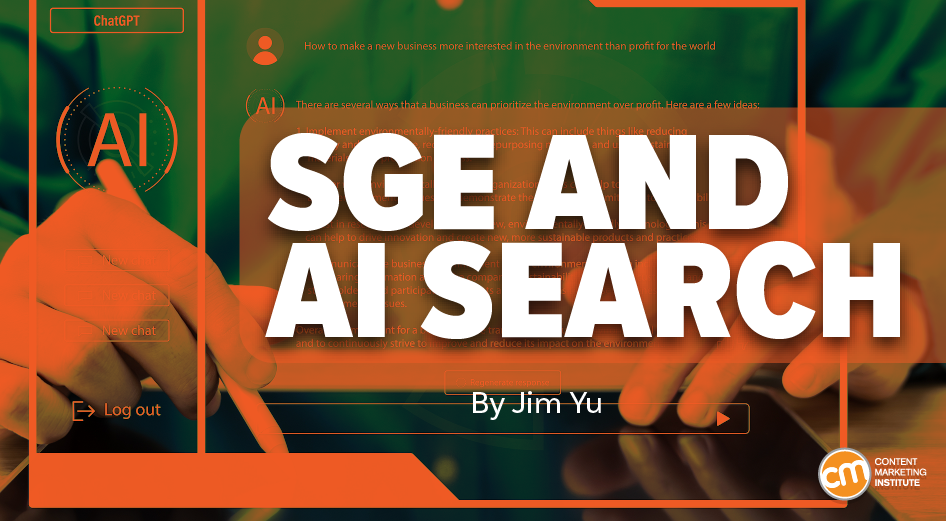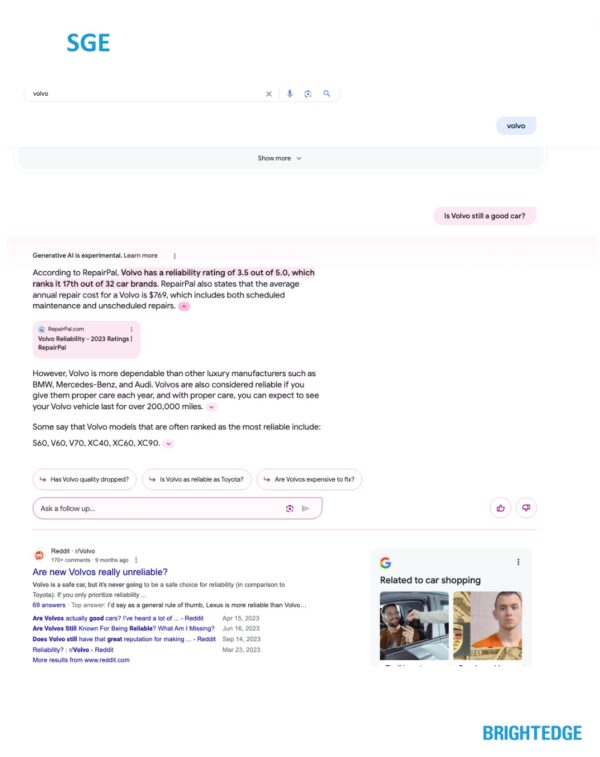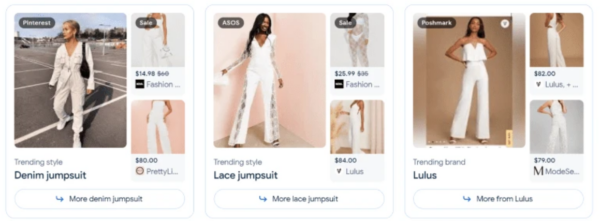MARKETING
How To Adapt Your SEO and Content Strategies for SGE and AI Experiences

A massive change is coming to search.
As Google experiments with AI in its standard search results and its Search Generative Experience (SGE), marketers must understand how to adapt their content strategies for new AI-impacted search experiences.
Since 2023, Google has been prolific in its AI experimentation, changing the way content is represented in search results. Its content-led SGE recently moved out of its testing lab to show up in a small percentage of results in Google’s main search interface.
Brands that produce content experiences that align with new search behaviors and focus on conversion stand a better chance to survive the search change.
Google adds generative AI, first-person reviews, and anti-spam actions
Your news feed says all. Search and generative AI investments are everywhere. And it’s not just Google — new entrants, such as Perplexity AI and You.com, are on the search scene. Meanwhile, OpenAI is working on a search engine powered by Microsoft’s Bing.
Still, Google owns the biggest market share in search, so let’s focus on the ways AI is affecting Google SEO.
Reddit and new content sources
Google added new content sources to its traditional results and Search Generative Experience.
In traditional search results, adding more content sources helps fine-tune its AI technologies. The recent content licensing deal with Reddit is a prime example. You can already see its content appearing more often in traditional search results.
This screenshot shows the search engine results for “Is Volvo a good car?” A discussion from the Volvo subreddit appears as the third result on the page (or fourth if you count the people-also-ask module.)
Click to enlarge
SGE appearance
The image below shows the SGE for the Volvo query. The first paragraphs are an AI-generated summary drawing on ratings from RepairPal (after an alert explaining the experimental nature of the generative AI content.)
Below the SGE summary, a search box prompts the visitor to ask a follow-up question. After that element, the Reddit discussion on Volvo reliability appears.

Click to enlarge
Showing Reddit content in SERPs lets Google show more first-person reviews and opinions (the experience element of Google’s EEAT (experience, expertise, authoritativeness, and trustworthiness) for search ratings.
But how will Google distinguish between subjective, objective, and informative opinions? With Reddit content, which can include positive and negative opinions readily on display, brands will need to follow relevant discussions on Reddit.
Google goes after spam sites
You may have read about Google’s latest update, which aims to avoid sites with low-quality (often AI-generated) content and give helpful content more prominence in SERPs.
This hammers home the message to avoid relying on generative AI alone for content creation. Content needs a human touch to earn the experience, expertise, authoritativeness, and trustworthiness that Google and, more importantly, searchers want to see.
Expect more penalties from Google for content that’s just churned out from AI prompts.
SGE’s impact on brands
SGE is the rollout that will impact every industry and content marketer.
My company, BrightEdge, built a tool to detect how and where search engines experiment with AI and new content formats. The chart below shows an estimate of the percentage of queries by industry affected by SGE results once it’s fully rolled out.
Health care will see the biggest impact, with 76% of its searches affected by SGE. Finance will be the least affected, with only 17% of queries impacted by SGE. Here’s how SGE will affect other industries:
- E-commerce (49%)
- B2B technology (48%)
- Insurance (45%)
- Education (44%)
- Restaurants (36%)
- Entertainment (36%)
- Travel (30%)

Click to enlarge
Once SGE rolls out completely, it will likely impact over $40 billion per year in ad revenue on Google for marketers per BrightEdge estimates.
How to prepare for SGE and changing search behavior
Google has always shown relevant sources and articles so searchers can make informed decisions. With the generative AI changes, Google’s engine now asserts an opinion. This represents a fundamental shift in how a search engine responds to queries.
Imagine you search the web to learn more about a BMW model you’re interested in. Previously, a Google search would display results with links such as BMW’s official site, Top Gear, Consumer Reports, and Carfax. The searcher then could choose the resources to explore and form an opinion about the vehicle.
In the generative AI world, Google’s primary result might not be a direct link to BMW’s website. Instead, it could be AI-generated content that provides an evaluative perspective. The AI content might include important factors to consider when looking at a BMW, such as the potential for high maintenance expenses or issues with parts availability due to supply chain challenges. This AI-curated summary will be presented before the searcher can see the resources with links for further exploration.
This shift may lead to reduced but higher-quality traffic. Brands are likely to experience better conversion rates. The reason? Consumers are more likely to act because they’ve been influenced by prior engagements and information provided by Google.
Still, you’ll need to adapt to the new search environment. Here are some tips on how to prepare.
Focus on the search basics
Solidify your foundation of SEO and website fundamentals. The essential elements will gain more significance as time progresses.
Make sure your website is optimized for user-friendliness and complies with Google’s guidelines regarding Core Web Vitals, Helpful Content, and EEAT (experience, expertise, authoritativeness, trustworthiness).
You may also want to review these tips for optimizing content for SGE.
Deepen your understanding of new search behaviors
Use data to grasp user and conversational intent, especially since these factors influence the AI-generated search results. Identifying high-value searches is essential.
Make sure that your content responds to the specific query and addresses its broader context to attract results for long-tail keyword searches.
Content generated by AI draws from reliable and credible sources. Ensure your brand’s content is considered an authoritative source.
The growing prominence of trusted sources and an increase in consumer reviews signal a pivotal change: Brands are likely to have less control over the customer journey.
Align content with other marketing disciplines
Search engine results now encompass an array of media types and formats, including social media, reviews, and news sources. So, teams in marketing, content creation, digital strategies, brand management, design, social media, and public relations must align closely.
Strategies for an AI-first future
According to BrightEdge research, 98% of enterprise organizations say they’ll prioritize SEO in 2024. And 94% of organizations are looking to integrate SEO into all marketing (omnichannel) strategies.
Strategies for adapting your content approach to new search experiences will vary by industry. Here are a few examples.
E-commerce: Google commonly presents content for e-commerce queries via product viewers. SGE replaces these with better, more visual, and informational (combined) content.
Google has experimented with several formats, including a general shopping result that details what a searcher would expect to see in a universal listing. However, as SGE results have evolved, so have the ways a user can view products.
This image shows an example of SGE’s integrated product viewer carousel with grouping for apparel, which displays multiple apparel options in a single display.

These tips will help you prepare for the various viewer modules (see viewer examples).
- Optimize for trend relevance: Aligning category pages with current trends can increase your chance of being included in SGE dynamic displays.
- Incorporate product reviews: Showing product reviews on your site boosts credibility.
- Present clear pricing Information: Use schema markup to highlight pricing details.
Travel, restaurants, and local: Places have long been a key module for Google. Now, we’re seeing the places module showing up in about 45% of SGE queries. So, make sure to include location-based keywords.
You might also try these optimization suggestions:
- Monitor and respond to reviews.
- Tailor your local listings for location-specific queries.
- Keep an eye on how and where SGE displays local modules. SGE displays local results even in queries without location-specific terms.
Entertainment: SGE entertainment results are primarily informational. But more reviews (and warnings for age-appropriate content) are appearing in both traditional search and SGE.
Get ready to shift your SEO thinking
Whoever provides the best experience for their target consumers will win in the new AI search experiences. Focus on third-party content reviews, social, PR, and brand authority. Expect your competitive landscape to change with new entrants that might eat into your market share.
Be aware, ready, and prepared to optimize for multiple AI search experiences.
All tools mentioned in this article were suggested by the author. If you’d like to suggest a tool, share the article on social media with a comment.
HANDPICKED RELATED CONTENT:
Cover image by Joseph Kalinowski/Content Marketing Institute


















